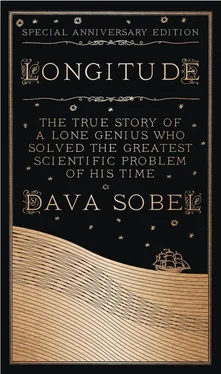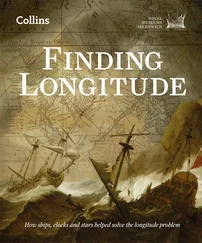In the course of their struggle to find longitude, scientists struck upon other discoveries that changed their view of the universe. These include the first accurate determinations of the weight of the Earth, the distance to the stars, and the speed of light.
As time passed and no method proved successful, the search for a solution to the longitude problem assumed legendary proportions, on a par with discovering the Fountain of Youth, the secret of perpetual motion, or the formula for transforming lead into gold. The governments of the great maritime nations—including Spain, the Netherlands, and certain city-states of Italy—periodically roiled the fervor by offering jackpot purses for a workable method. The British Parliament, in its famed Longitude Act of 1714, set the highest bounty of all, naming a prize equal to a king’s ransom (several million dollars in today’s currency) for a “Practicable and Useful” means of determining longitude.
English clockmaker John Harrison, a mechanical genius who pioneered the science of portable precision timekeeping, devoted his life to this quest. He accomplished what Newton had feared was impossible: He invented a clock that would carry the true time from the home port, like an eternal flame, to any remote corner of the world.
Harrison, a man of simple birth and high intelligence, crossed swords with the leading lights of his day. He made a special enemy of the Reverend Nevil Maskelyne, the fifth astronomer royal, who contested his claim to the coveted prize money, and whose tactics at certain junctures can only be described as foul play.
With no formal education or apprenticeship to any watchmaker, Harrison nevertheless constructed a series of virtually friction-free clocks that required no lubrication and no cleaning, that were made from materials impervious to rust, and that kept their moving parts perfectly balanced in relation to one another, regardless of how the world pitched or tossed about them. He did away with the pendulum, and he combined different metals inside his works in such a way that when one component expanded or contracted with changes in temperature, the other counteracted the change and kept the clock’s rate constant.
His every success, however, was parried by members of the scientific elite, who distrusted Harrison’s magic box. The commissioners charged with awarding the longitude prize—Nevil Maskelyne among them—changed the contest rules whenever they saw fit, so as to favor the chances of astronomers over the likes of Harrison and his fellow “mechanics.” But the utility and accuracy of Harrison’s approach triumphed in the end. His followers shepherded Harrison’s intricate, exquisite invention through the design modifications that enabled it to be mass produced and enjoy wide use.
An aged, exhausted Harrison, taken under the wing of King George III, ultimately claimed his rightful monetary reward in 1773—after forty struggling years of political intrigue, international warfare, academic backbiting, scientific revolution, and economic upheaval.
All these threads, and more, entwine in the lines of longitude. To unravel them now—to retrace their story in an age when a network of orbiting satellites can nail down a ship’s position within a few feet in just a moment or two—is to see the globe anew.
They that go down to the Sea in Ships, that do business in great waters, these see the works of the Lord, and His wonders in the deep .
—PSALM 107
Dirty weather,” Admiral Sir Clowdisley Shovell called the fog that had dogged him twelve days at sea. Returning home victorious from Gibraltar after skirmishes with the French Mediterranean forces, Sir Clowdisley could not beat the heavy autumn overcast. Fearing the ships might founder on coastal rocks, the admiral summoned all his navigators to put their heads together.
The consensus opinion placed the English fleet safely west of Île d’Ouessant, an island outpost of the Brittany peninsula. But as the sailors continued north, they discovered to their horror that they had misgauged their longitude near the Scilly Isles. These tiny islands, about twenty miles from the southwest tip of England, point to Land’s End like a path of stepping-stones. And on that foggy night of October 22, 1707, the Scillies became unmarked tombstones for two thousand of Sir Clowdisley’s troops.
The flagship, the Association , struck first. She sank within minutes, drowning all hands. Before the rest of the vessels could react to the obvious danger, two more ships, the Eagle and the Romney , pricked themselves on the rocks and went down like stones. In all, four of the five warships were lost.
Only two men washed ashore alive. One of them was Sir Clowdisley himself, who may have watched the fifty-seven years of his life flash before his eyes as the waves carried him home. Certainly he had time to reflect on the events of the previous twenty-four hours, when he made what must have been the worst mistake in judgment of his naval career. He had been approached by a sailor, a member of the Association’s crew, who claimed to have kept his own reckoning of the fleet’s location during the whole cloudy passage. Such subversive navigation by an inferior was forbidden in the Royal Navy, as the unnamed seaman well knew. However, the danger appeared so enormous, by his calculations, that he risked his neck to make his concerns known to the officers. Admiral Shovell had the man hanged for mutiny on the spot.
No one was around to spit “I told you so!” into Sir Clowdisley’s face as he nearly drowned. But as soon as the admiral collapsed on dry sand, a local woman combing the beach purportedly found his body and fell in love with the emerald ring on his finger. Between her desire and his depletion, she handily murdered him for it. Three decades later, on her deathbed, this same woman confessed the crime to her clergyman, producing the ring as proof of her guilt and contrition.
The demise of Sir Clowdisley’s fleet capped a long saga of seafaring in the days before sailors could find their longitude. Page after page from this miserable history relates quintessential horror stories of death by scurvy and thirst, of ghosts in the rigging, and of landfalls in the form of shipwrecks, with hulls dashed on rocks and heaps of drowned corpses fouling the beaches. In literally hundreds of instances, a vessel’s ignorance of her longitude led swiftly to her destruction.
Launched on a mix of bravery and greed, the sea captains of the fifteenth, sixteenth, and seventeenth centuries relied on “dead reckoning” to gauge their distance east or west of home port. The captain would throw a log overboard and observe how quickly the ship receded from this temporary guidepost. He noted the crude speedometer reading in his ship’s logbook, along with the direction of travel, which he took from the stars or a compass, and the length of time on a particular course, counted with a sandglass or a pocket watch. Factoring in the effects of ocean currents, fickle winds, and errors in judgment, he then determined his longitude. He routinely missed his mark, of course—searching in vain for the island where he had hoped to find fresh water, or even the continent that was his destination. Too often, the technique of dead reckoning marked him for a dead man.
Long voyages waxed longer for lack of longitude, and the extra time at sea condemned sailors to the dread disease of scurvy. The oceangoing diet of the day, devoid of fresh fruits and vegetables, deprived them of vitamin C, and their bodies’ connective tissue deteriorated as a result. Their blood vessels leaked, making the men look bruised all over, even in the absence of any injury. When they were injured, their wounds failed to heal. Their legs swelled. They suffered the pain of spontaneous hemorrhaging into their muscles and joints. Their gums bled, too, as their teeth loosened. They gasped for breath, struggled against debilitating weakness, and when the blood vessels around their brains ruptured, they died.
Читать дальше










